
In geology and mineralogy, a mineral or mineral species is, broadly speaking, a solid substance with a fairly well-defined chemical composition and a specific crystal structure that occurs naturally in pure form.
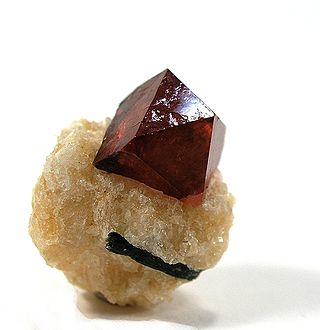
Zircon is a mineral belonging to the group of nesosilicates and is a source of the metal zirconium. Its chemical name is zirconium(IV) silicate, and its corresponding chemical formula is ZrSiO4. An empirical formula showing some of the range of substitution in zircon is (Zr1–y, REEy)(SiO4)1–x(OH)4x–y. Zircon precipitates from silicate melts and has relatively high concentrations of high field strength incompatible elements. For example, hafnium is almost always present in quantities ranging from 1 to 4%. The crystal structure of zircon is tetragonal crystal system. The natural color of zircon varies between colorless, yellow-golden, red, brown, blue, and green.
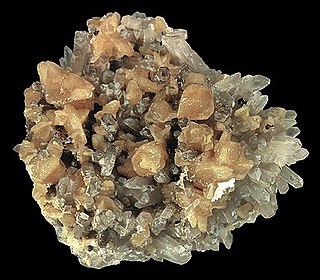
Monazite is a primarily reddish-brown phosphate mineral that contains rare-earth elements. Due to variability in composition, monazite is considered a group of minerals. The most common species of the group is monazite-(Ce), that is, the cerium-dominant member of the group. It occurs usually in small isolated crystals. It has a hardness of 5.0 to 5.5 on the Mohs scale of mineral hardness and is relatively dense, about 4.6 to 5.7 g/cm3. There are five different most common species of monazite, depending on the relative amounts of the rare earth elements in the mineral:

Cristobalite is a mineral polymorph of silica that is formed at very high temperatures. It has the same chemical formula as quartz, SiO2, but a distinct crystal structure. Both quartz and cristobalite are polymorphs with all the members of the quartz group, which also include coesite, tridymite and stishovite. It is named after Cerro San Cristóbal in Pachuca Municipality, Hidalgo, Mexico.
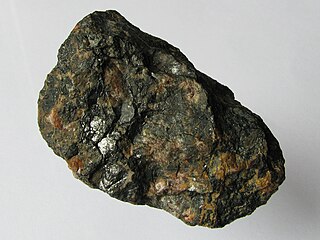
Coffinite is a uranium-bearing silicate mineral with formula: U(SiO4)1−x(OH)4x.

Forsterite (Mg2SiO4; commonly abbreviated as Fo; also known as white olivine) is the magnesium-rich end-member of the olivine solid solution series. It is isomorphous with the iron-rich end-member, fayalite. Forsterite crystallizes in the orthorhombic system (space group Pbnm) with cell parameters a 4.75 Å (0.475 nm), b 10.20 Å (1.020 nm) and c 5.98 Å (0.598 nm).

Thorite, (Th,U)SiO4, is a rare nesosilicate of thorium that crystallizes in the tetragonal system and is isomorphous with zircon and hafnon. It is the most common mineral of thorium and is nearly always strongly radioactive. Thorite was discovered in 1828 on the island of Løvøya, Norway, by the vicar and mineralogist, Hans Morten Thrane Esmark. First specimens of Thorite were sent to his father, Jens Esmark, who was a professor of mineralogy and geology. It was named in 1829 to reflect its thorium content.

Silicate minerals are rock-forming minerals made up of silicate groups. They are the largest and most important class of minerals and make up approximately 90 percent of Earth's crust.

Clinohumite is an uncommon member of the humite group, a magnesium silicate according to the chemical formula (Mg, Fe)9(SiO4)4(F,OH)2. The formula can be thought of as four olivine (Mg2SiO4), plus one brucite (Mg(OH)2). Indeed, the mineral is essentially a hydrated olivine and occurs in altered ultramafic rocks and carbonatites. Most commonly found as tiny indistinct grains, large euhedral clinohumite crystals are sought by collectors and occasionally fashioned into bright, yellow-orange gemstones. Only two sources of gem-quality material are known: the Pamir Mountains of Tajikistan, and the Taymyr region of northern Siberia. It is one of two humite group minerals that have been cut into gems, the other being the much more common chondrodite.

Afwillite is a calcium hydroxide nesosilicate mineral with formula Ca3(SiO3OH)2·2H2O. It occurs as glassy, colorless to white prismatic monoclinic crystals. Its Mohs scale hardness is between 3 and 4. It occurs as an alteration mineral in contact metamorphism of limestone. It occurs in association with apophyllite, natrolite, thaumasite, merwinite, spurrite, gehlenite, ettringite, portlandite, hillebrandite, foshagite, brucite and calcite.
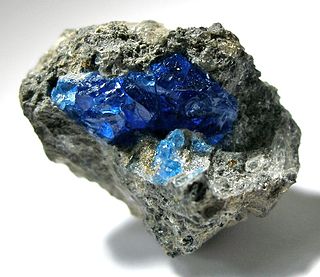
Hauyne or haüyne, also called hauynite or haüynite, is a Rare tectosilicate sulfate mineral with endmember formula Na3Ca(Si3Al3)O12(SO4). As much as 5 wt % K2O may be present, and also H2O and Cl. It is a feldspathoid and a member of the sodalite group. Hauyne was first described in 1807 from samples discovered in Vesuvian lavas in Monte Somma, Italy, and was named in 1807 by Brunn-Neergard for the French crystallographer René Just Haüy (1743–1822). It is sometimes used as a gemstone.
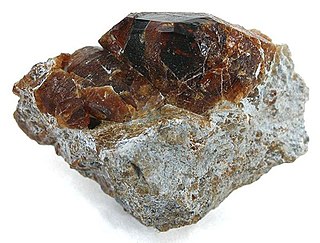
Chondrodite is a nesosilicate mineral with formula (Mg,Fe)
5(SiO
4)
2(F,OH,O)
2. Although it is a fairly rare mineral, it is the most frequently encountered member of the humite group of minerals. It is formed in hydrothermal deposits from locally metamorphosed dolomite. It is also found associated with skarn and serpentinite. It was discovered in 1817 at Pargas in Finland, and named from the Greek for "granule", which is a common habit for this mineral.

Wadsleyite is an orthorhombic mineral with the formula β-(Mg,Fe)2SiO4. It was first found in nature in the Peace River meteorite from Alberta, Canada. It is formed by a phase transformation from olivine (α-(Mg,Fe)2SiO4) under increasing pressure and eventually transforms into spinel-structured ringwoodite (γ-(Mg,Fe)2SiO4) as pressure increases further. The structure can take up a limited amount of other bivalent cations instead of magnesium, but contrary to the α and γ structures, a β structure with the sum formula Fe2SiO4 is not thermodynamically stable. Its cell parameters are approximately a = 5.7 Å, b = 11.71 Å and c = 8.24 Å.
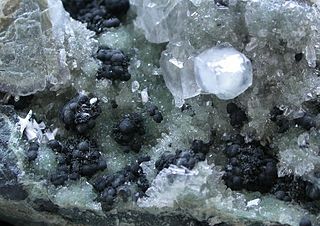
Julgoldite is a member of the pumpellyite mineral series, a series of minerals characterized by the chemical bonding of silica tetrahedra with alkali and transition metal cations. Julgoldites, along with more common minerals like epidote and vesuvianite, belong to the subclass of sorosilicates, the rock-forming minerals that contain SiO4 tetrahedra that share a common oxygen to form Si2O7 ions with a charge of 6− (Deer et al., 1996). Julgoldite has been recognized for its importance in low grade metamorphism, forming under shear stress accompanied by relatively low temperatures (Coombs, 1953). Julgoldite was named in honor of Professor Julian Royce Goldsmith (1918–1999) of the University of Chicago.

Hafnon is a hafnium nesosilicate mineral, chemical formula (Hf,Zr)SiO4 or (Hf,Zr,Th,U,Y)SiO4. In natural zircon ZrSiO4 part of the zirconium is replaced by the very similar hafnium and so natural zircon is never pure ZrSiO4. A zircon with 100% hafnium substitution can be made synthetically and is hafnon.

Tobermorite is a calcium silicate hydrate mineral with chemical formula: Ca5Si6O16(OH)2·4H2O or Ca5Si6(O,OH)18·5H2O.

Malayaite is a calcium tin silicate mineral with formula CaSnOSiO4. It is a member of the titanite group.

Vlasovite is a rare inosilicate (chain silicate) mineral with sodium and zirconium, with the chemical formula Na2ZrSi4O11. It was discovered in 1961 at Vavnbed Mountain in the Lovozero Massif, in the Northern Region of Russia. The researchers who first identified it, R P Tikhonenkova and M E Kazakova, named it for Kuzma Aleksevich Vlasov (1905–1964), a Russian mineralogist and geochemist who studied the Lovozero massif, and who was the founder of the Institute of Mineralogy, Geochemistry, and Crystal Chemistry of Rare Elements, Moscow, Russia.
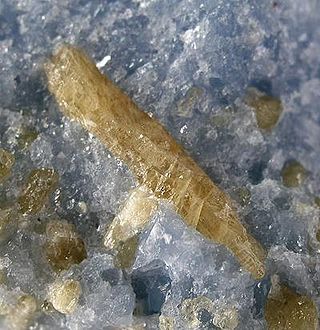
Fluorellestadite is a rare nesosilicate of calcium, with sulfate and fluorine, with the chemical formula Ca10(SiO4)3(SO4)3F2. It is a member of the apatite group, and forms a series with hydroxylellestadite.

Sinoite is rare mineral with the chemical formula Si2N2O. It was first found in 1905 in chondrite meteorites and identified as a distinct mineral in 1965. Sinoite crystallizes upon meteorite impact as grains smaller than 0.2 mm surrounded by Fe-Ni alloys and the mineral enstatite. It is named after its SiNO composition and can be prepared in the laboratory as a silicon oxynitride ceramic.





















